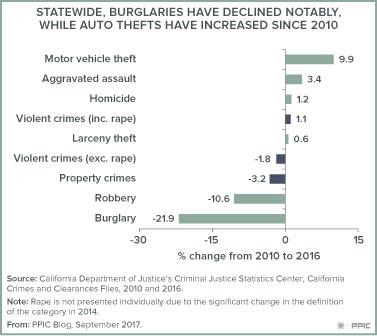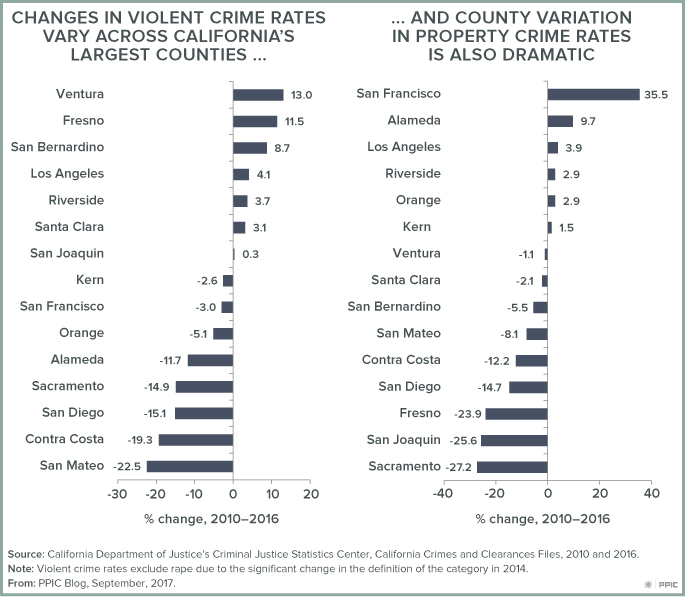In 2011, California embarked on a series of criminal justice reforms, decreasing the state’s reliance on costly incarceration—and raising fears about the impact on public safety. A look at recently released crime numbers from the California Department of Justice show that while auto thefts are up almost 10%, the state has not seen a broad surge in crime since the reforms started. The violent crime rate is up 1.1% (and when adjusted for an important definitional change, is in fact down about 1%), while the property crime rate is down 3.2%. However, these statewide numbers mask substantial differences across counties.
Prompted by a federal court mandate to reduce the population of the state’s overcrowded prisons, California enacted public safety realignment in 2011. This historic reform shifted the management of lower-level felons from state prison and parole systems to county jail and probation systems. Since then—with the state still unable to meet the federal mandate—voters have passed three significant initiatives: Proposition 36 in 2012, Proposition 47 in 2014, and Proposition 57 in 2016. Due to the combined impact of these reforms, the state’s incarceration rate has declined dramatically and is now at a level not seen since the early 1990s.
 While reforms were unquestionably needed—the state faced a possible federal order to release more than 30,000 prisoners early—critics have voiced concerns that public safety may be negatively affected and have asked whether less incarceration would reverse California’s long-term decline in crime rates.
While reforms were unquestionably needed—the state faced a possible federal order to release more than 30,000 prisoners early—critics have voiced concerns that public safety may be negatively affected and have asked whether less incarceration would reverse California’s long-term decline in crime rates.
Have reforms affected crime in California? A comparison of 2016 crime rates to those of 2010, the year before any of these reforms were implemented, provides a useful starting point.
The 2016 violent crime rate of 444 per 100,000 residents is up somewhat (1.1%) from the 2010 rate of 439 per 100,000 residents. However, the FBI implemented a change in 2014 that expanded the definition of sexual crimes that constitute rape. According to the FBI’s Uniform Crime Report, the new definition added about 38% to the number of reported rapes in 2014 in California, increasing the violent crime rate by about 8 more violent crimes per 100,000 residents. If we adjust the 2016 violent crime rate accordingly, from 444 to 436 per 100,000 residents, we find that this more comparable measure indicates a slight drop in violent crime (of about 1%) between 2010 and 2016.
The property crime rate in 2016 of 2,545 per 100,000 residents is down 3.2% from 2010 and is the second lowest rate observed since 1960 (the lowest was 2,459 per 100,000 residents in 2014). While the rate of auto theft is up 9.9%, burglaries have been decreasing noticeably since 2012 and are now down 21.9% from 2010. Larceny theft has changed very little (up less than 1%).
The picture is more complicated at the county level. A look at the 15 largest California counties shows that five saw double-digit drops in their violent crime rates between 2010 and 2016: San Mateo, Contra Costa, San Diego, Sacramento, and Alameda. But Ventura and Fresno Counties experienced increases of more than 10%. And while the property crime rate dropped more than 20% in three counties—Sacramento, San Joaquin, and Fresno—it went up a staggering 35.5% in San Francisco. Alameda County saw an increase of almost 10%.
 How can we explain these differences? Before rushing to conclusions, there are several questions that need to be answered first. How have reforms affected factors such as arrests and incarceration? Do these differ across counties and what is their relationship to crime rates? Also, California’s crime trends may be affected by factors unrelated to recent reforms. How do statewide trends compare to what other states are seeing? Finally, have California’s reforms improved outcomes for those released from our jails and prisons? If so, this could help lower crime rates in the coming years. Our goal at PPIC is to address these important questions in our upcoming research.
How can we explain these differences? Before rushing to conclusions, there are several questions that need to be answered first. How have reforms affected factors such as arrests and incarceration? Do these differ across counties and what is their relationship to crime rates? Also, California’s crime trends may be affected by factors unrelated to recent reforms. How do statewide trends compare to what other states are seeing? Finally, have California’s reforms improved outcomes for those released from our jails and prisons? If so, this could help lower crime rates in the coming years. Our goal at PPIC is to address these important questions in our upcoming research.


